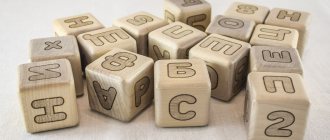Distinguish between "left" and "right"
For studying in general and so as not to confuse the concepts of “clockwise” and “counterclockwise” as well.
Have a general understanding of time
We explain to the child the concepts of “yesterday”, “today”, “tomorrow”; "past present Future"; “morning”, “day”, “evening”, “night”, “day”. Often children themselves associate time with a specific event: “in the morning I did exercises”, “at lunch I ate soup”, “before going to bed I brushed my teeth”, etc. Therefore, when explaining the above concepts, it is best for a parent to tie specific events to them.
Correct your child carefully if he makes mistakes somewhere. It is important that he does not develop a false understanding of time.
Have you successfully completed the preparatory stage? Now we can teach the child to understand time using a clock with arrows.
We teach a child to understand time using a clock with arrows
Oh, these adults! And why do they only allow you to watch cartoons for about 15 or 20 minutes? For children, time is an incomprehensible number. To figure out where it comes from, you will need a watch with hands. If there are no such things at home, but only electronic ones, it will be completely difficult for the child to understand what time is. Therefore, the first step for a parent is to acquire a wall clock or a special children's clock, on which the numbers and arrows will be clearly visible.
Introducing the child to the structure of the clock
First, explain to your child the concepts of “dial”, “day”, “hours”, “minutes”, “seconds”; “exactly one hour”, “half an hour”, “quarter of an hour”, tell us about the hour, minute, second hands. Please note that all arrows have different lengths. Let the child observe which of the arrows is the fastest and which one practically stands still. And how long does it take for each to complete the whole circle?
Be sure to connect all the basic concepts into one logical chain: there are 24 hours in a day, 1 hour is 60 minutes, and 1 minute is 60 seconds. Do not ignore the concepts of “clockwise” and “counterclockwise”. Let your child understand that time always moves forward.
We teach a child to “read” the hour and minute hands at the same time
First of all, teach your child to count minutes in intervals divisible by 5. Minutes are not indicated on a regular clock, so this skill needs to be practiced. You can come up with a legend that each number on the dial has its own “shadow”. 1 is 5 minutes, 2 is 10 minutes, 3 is 15 minutes, etc. The “shadow” can only be seen when the minute hand is pointing to the number. When your child can easily navigate five-minute intervals, tell him about smaller intervals.
The hour hand also has two meanings. In the first half of the day we see the numbers as they appear on the dial, but after a hearty afternoon snack at 12:00 they begin to “get fat”: 1 turns into 12, 2 into 14, etc. A funny analogy will help your child grasp the meaning faster.
The ability to determine time using a clock with hands must be reinforced with specific examples. Draw your child's attention to the clock more often. Correct him if he says the time incorrectly.
The best gift for a child who is learning to tell time by clock is a wristwatch. With them, he will become more willing to answer the question “What time is it?” and will definitely ask you about this in order to check with his “walkers”.
Ideally, a child should have a “draft” watch that he can “exploit” as he pleases: set the time on it, add “shadows” to each of the numbers, sign the names of the hands. For training, you can use an old non-working clock (wall or table clock). You need to remove the glass in them so that the hands can be rotated. If you haven't found one like this at home, we suggest you make your own.
Conversation in the senior group of kindergarten. How did the clock come into being?
A story for children about how the clock came into being.
Do you like riddles?
Then listen. Behind the glass door, someone's heart is beating, so quietly, so quietly. How does it beat? and what kind of heart is this? Do you know how long ago clocks appeared? And who came up with it? And in general, why does a person need a watch? When we use the word “clock,” we mean a mechanism for measuring time. But, did you know that man invented many ways to measure time long before the first mechanical watches were invented? At first, people measured time from sunrise to sunset. What is this period of time called? People noticed that the shadow of objects falling on the ground is different in different parts of the day, and people came up with a clock like this
and in Egypt they were called solar.
What do you think, were these watches comfortable? How do you measure time at night? The stars also served people as giant clocks, because man long ago noticed that different stars were visible at different times at night. The ancient Egyptians divided the night into 12 time periods, each of which began with the rising of one of the 12 stars. By the way, how many intervals did the Egyptians divide the day into? Sundials were not entirely convenient, so people came up with a water clock, and they showed the time both on a sunny day and in bad weather. In memory of these hours we say: “A lot of water has passed under the bridge since then.”
Were these hours comfortable? The man is restless, so he came up with this mechanism, using fire and water to measure time. It turns out that time can be measured using a burning candle.
Were these hours comfortable? About 2 thousand years ago, man invented another device for measuring time - the hourglass.
“Time flows” in an hourglass, or rather not time, but the sand with which it is measured. Where have you seen such a watch? Right at the clinic. This clock...consists of two communicating vessels, one of which is filled with sand. Is this watch comfortable? The first true mechanical watches were invented more than twelve hundred years ago. In this watch, a coil with a chain and a weight at the end is attached to the mechanism. Under the influence of the load, the coil rotated and the chain unwound. with the help of gears and regulators, the movement was transmitted to the arrow, which moved along the dial.
What other watches do you know? Correct A quartz watch is a watch that uses a microscopic quartz crystal in its mechanism. Quartz is used only in watches that operate on a battery, that is, electronic and electro-mechanical. Warm-up: “circle game” (passing the arrow, the guys say a word related to time)
We recommend watching:
Summary of a thematic conversation in the senior group on the topic: Friendship Sviridov's music for children. Conversation with children of the senior group Thematic conversation for children in the senior group. Electrical appliances A story about a spring holiday for older children. Reindeer Herder Day
Similar articles:
Conversation about courage with older preschoolers
Conversation about hard work in the preparatory group
Conversation about envy with preschoolers of the preparatory group
The most important events in the history of Russia for children 5-8 years old
About Russian heroes for children 6-7 years old
Making homemade watches
A homemade clock will help make time more tangible. If you have the necessary materials, their creation will take no more than 15 minutes.
How to make a watch yourself
The basis for the dial can be a disposable plate or a circle made of cardboard. We draw the circle in half, then in half again and apply the first numbers. Next, carefully divide each quarter into three parts and add the remaining numbers. The dial is ready, which means it's time to attach the hands. We cut them out of cardboard of different colors and attach them to the circle using a button. We place the resulting model of the clock next to the real clock.
When creating your own watch, it will be useful to go over the concepts you have already learned. We drew the circle into four parts - we remembered about the “quarter hour”, attached an hour hand - we remembered its function, etc.
Homemade watches may look unusual. For example, like this:
Games and tasks with a clock
Games and tasks will help you strengthen your ability to tell time using a clock.
"What time is it now"
Show your child how the arrows move. Change their position and call the time. Then have the child do the same exercise. Change the time clockwise and counterclockwise.
Let's complicate the game. We show the time on the clock and associate it with events (“it’s 7:00”, at this time we wake up”, “it’s 18:00”, at this time we have dinner”, etc.). Now we invite the child to pretend to live the whole day.
“Drawing pizza”
The good thing about a homemade dial is that you can make your own notes on it. Ask your child to draw lines from the center of the dial to the numbers and shade each sector with a different color. You will get a “colored pie” or “colored pizza” (this will make it easier to understand 5-minute intervals). Label the second values of each number (2 - 10, 3 - 15) and minutes (from 1 to 60).
"Daily regime"
Take a piece of paper, write down the daily routine, and together with your child, illustrate it with images of a clock that indicates a period of time (8:00 - time for school, 15:00 - time to do homework, etc.). Hang it above your child's bed or desk. This way the child will learn not only to do everything on time, but also to navigate in time.
Pay your child's attention to how much time he spends on this or that action. This way you can teach him to be punctual from an early age.
“Two options for telling the time”
Tell your child that time can be called in different ways (for example, 1 hour 18 minutes is eighteen minutes past two, etc.). Write down the second, more complex option on a piece of paper, and indicate the hint numbers to make it easier for the child to cope (example: “five minutes to eight”, the hint numbers are 9, 5, 5, 1). Gradually remove the prompts.
Methodology for the development of temporal representations of preschoolers in different age groups
Methods for developing temporary relationships are described in detail in the works of T.I. Erofeeva, A.A. Stolyara, L.S. Metlina, T.D. Richterman and others. This paper provides a brief overview of the “Program of Education and Training in Kindergarten” based on the work of A.A. Carpenter. There are several aspects of these techniques that reflect the gradual development of the child’s analytical apparatus:
1) familiarizing children with the parts of the day,
2) familiarization with the calendar,
3) developing an understanding of time sequences.
For reinforcement, didactic material is used, which consists of pictures with specific activities that are associated with a specific time of day. Poems and stories are read, which describe the child’s actions characteristic of each part of the day. Logical word games are also used. For example: in the game “Missing Word,” the teacher deliberately misses a word: “We have breakfast in the morning, and lunch...?”
After mastering this material, you can move on to familiarize yourself with the adverbs “today,” “yesterday,” “now,” “tomorrow” and associate their sequence with the daily cycle of three days. To do this, you need to talk about one and bright event for children three times in the present, future and past tense. Gradually, by the end of the year, the children in the middle group should develop a basic understanding of the fluidity and continuity of time.
It should be noted that systematic work with the calendar helps children develop knowledge not only about the current date, but also about the fluidity of time, its periodicity, the recurrence of months and the irreversibility of time processes, i.e. practically gives an idea of the main characteristics of time.
The development of a sense of time, as mentioned above, is a necessary condition for any activity. Therefore, children need to create various situations, focusing their attention on the duration of various vital intervals, clearly showing what can be done during this time, teaching children to measure and then evaluate time intervals in the process of activity, and carrying out simple preliminary planning of their actions. In general terms, we can highlight a number of foundations for the successful development of a “sense of time”:
ability to estimate time intervals without a clock.
Organization and methodology of work:
1) familiarizing children with durations of 1, 3, 5 and 10 minutes, while using a stopwatch, an hourglass, and a construction clock for children to perceive the duration of the indicated intervals;
2) ensuring the experience of the duration of these intervals in different types of activity;
3) children learn to perform work within a specified period (1, 3, 5 minutes), for which they were taught to measure time and estimate the duration of an activity, and regulate the pace of its implementation.
The work is carried out in stages.
The program material for the first 3 lessons includes the following tasks:
1) introduce children to the duration of 1 minute;
2) teach the ability to control time using an hourglass in the process of performing various activities;
3) create a feeling of satisfaction from the ability to complete a task on time.
Work with 3 and 5 minute intervals is structured in a similar way. In this case, children, as a rule, work with an hourglass. It is more convenient to start using a digital watch by studying the 5-minute interval, because this interval in hours is easy to see. Based on the acquired ideas about a 1-minute interval, children study the model of a clock. To do this, they usually use a model whose arrows can move freely. Gradually the classes become more difficult. In order for children to use time as a regulator of activity not only in classes, but also in independent activities, their knowledge of the hourly routine of life in kindergarten is clarified. Children move the hands on the mock-up clock and, setting the appropriate time, tell what they were doing at that time. Thus, in the process of activities and games, children develop their first planning skills. It is worth noting that when teaching children to be precise in time, it is necessary to strictly adhere to the scheduled deadlines, since any deviations from the scheduled time are perceived especially sharply by them. The child will be able to learn the time sequence of activities and events when he practically acts with the time links proposed to him. He will be able to compare the current state with the previous and subsequent ones only when each link of the observed time sequence is perceived not in itself, but in a system. To do this, the teacher must explain the material in the sequence necessary for the children, help the children reproduce, supplement and restore it, and also gradually achieve independent determination of the time frame for their activities.
Source










